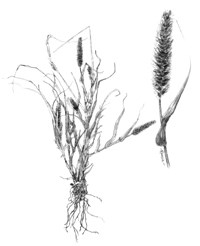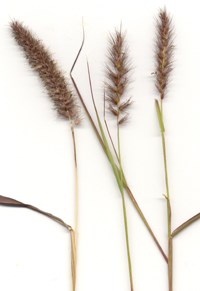
Craig Stocks Although the monument is home to several native grasses, buffelgrass has invaded this ecosystem for decades. Although buffelgrass was once introduced by humans, it is now being aggressively removed by humans. Today, both public and private landowners deal with the consequences of introducing non-native species to an area. Lessons of land management and working with the ecosystem, instead of against it, are abound in this complicated relationship between the land, plants, and humans. Learn about the history and effects of invasive plants on the Invasive Plants page. 
NPS photo Buffelgrass: Invading the Sonoran Desert!Buffelgrass (Pennisetum ciliare or Cenchrus ciliaris) is native to south and southwest Asia, and Africa, where it is considered a normal and healthy plant in its home ecosystems. This grass is very hardy and can withstand heavy grazing and fire. It was brought to the desert southwest of North America as cattle forage, but it has since become aggressively invasive, displacing native species. This highly flammable grass spreads across terrain that is naturally sparse in plants, creating a fire hazard where there once was little danger. After a fire, buffelgrass springs back quicker than fire sensitive native plants, creating huge stands of just that species, and making recovery a challenge. Within just decades of introduction to an area, buffelgrass can cause full-blown infestations and lasting damage to the natural balance of an ecosystem. 
NPS photo How to Identify BuffelgrassCity dwellers and travelers in southern Arizona have probably seen buffelgrass. It is very common in southern Arizona cities and towns and along roadsides, as it does well in disturbed places. Buffelgrass typically grows in shrubby clumps 3-4 feet tall (0.9-1.2 m), with many stems growing from a central point. Buffelgrass is straw-colored during the dry parts of the year, and quickly turns bright green with rain. In the cool winter, the edges of the leaves may turn reddish or purplish. The flowers grow on a long spike that sways in the wind, and the seeds have long stiff fibers that give the spike a “bottlebrush” appearance. Compared to many similar-looking native grasses, buffelgrass have a rough stem and leaf blades if you gently run your fingers from bottom to top. The leaves are often longer and wider than our native grasses, and the “bottlebrush” seeds appear tougher and less feathery than native grass seeds. 
NPS photo A History of ProblemsBuffelgrass is a non-native species in the Sonoran Desert, and it causes harm to the plants and animals that are native, making it an invasive species. Some things to consider about buffelgrass (and other invasive species) are how and why it came to the area and why it is successful. Why Was Bufflegrass Brought Here?Buffelgrass is native to regions of Africa and Asia and did not occur in the in the Americas until people brought seeds here. This plant is a powerful soil stabilizer that is good for reducing dust and can be used as a forage for cattle. The U.S. Department of Agriculture’s Plant Materials Center in Tucson first introduced buffelgrass to the Sonoran Desert in the mid-1930s. Buffelgrass proved to be a useful ground cover plant, and for years, the USDA, academic institutions, and others promoted its use on public and private land. This early endorsement set the stage for an invasion, and in the 1960s and 1970s, buffelgrass spread into natural areas in northern Mexico, and southern Arizona. Why is Buffelgrass So Successful in the Sonoran Desert?Buffelgrass is a tenacious plant with adaptations that help it thrive where it is introduced. Each plant can produce many seeds, which are easily dispersed. Wind may carry the fluffy seeds for long distances, or the seeds may "hitch a ride" on clothing or shoes. Buffelgrass is very efficient at using water and nutrients, and reproduces quickly, choking out delicate native species that are not used to the competition. What Does this Mean for Organ Pipe Cactus National Monument?The implications of buffelgrass in the monument are serious. Many ecologists who are familiar with the spread of buffelgrass in Mexico and Arizona are concerned that this invasive species will displace important native species of the Sonoran Desert. Ecologists and botanists in the monument expect invasions to occur along roads and trails and to spread outward from there. Recently burned areas are also of concern. Buffelgrass is common in the State of Sonora, Mexico, and in southern Arizona, with State Highway 85 and Mexico Highway 2 providing ample space for the grass to spread. 
NPS photo What Can We Do About It?If we rally our community, both local and visiting, we may slow down the invasion, and buy some time to learn how to control it. You can offer valuable help in this effort by doing one or more of the following:
Invasives in Arizona |
Last updated: September 21, 2023
